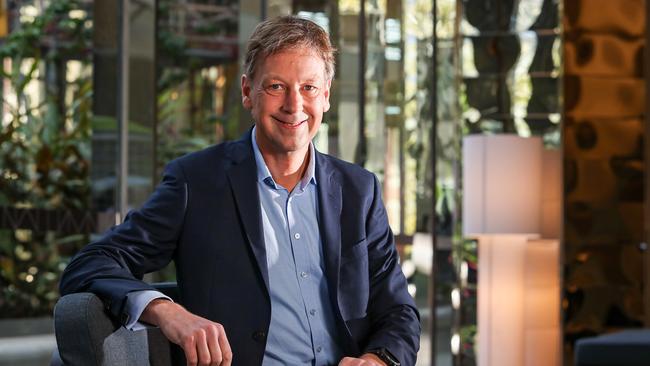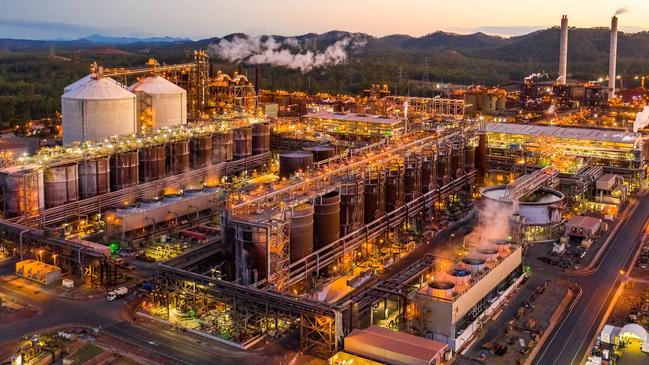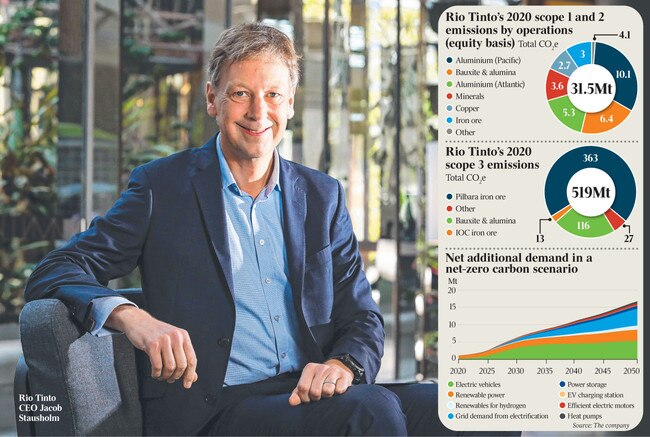Rio Tinto pledges to halve carbon footprint by 2030
Rio Tinto will spend $10bn to slash its carbon emissions over the next decade, dramatically escalating the pace of its goals.

Rio Tinto will dramatically escalate efforts to reduce its massive global carbon footprint over the next decade, committing to spending $US7.5bn ($10bn) to halve its carbon footprint by 2030.
Rio’s previous goal, of reducing carbon emissions from its own operations by 15 per cent by 2030 was greeted with derision by green groups and climate-focused investors when it was first announced in 2020.
The company said on Wednesday, ahead of its annual investor day presentations, it would bring forward that 15 per cent target to 2025, and would commit to halving its scope 1 and 2 emissions by 2030.
Rio Tinto chief executive Jakob Stausholm said the miner would also accelerate its efforts to help its customers decarbonise their own operations.
“All our commodities are vital for the energy transition and continue to benefit from ongoing urbanisation,” Mr Stausholm said.
“We have a clear pathway to decarbonise our business and are actively developing technologies that will enable our customers and our customers’ customers to decarbonise.”
Rio said it would roll out 1GW of solar and wind power to reduce carbon emissions from its Pilbara iron ore operations as part of the plan. Since Rio’s previous pledge to reduce carbon emissions from its own operations by 15 per cent by 2030 it has been eclipsed by commitments made by other major miners, most notably by Fortescue Metals’ promise of reaching net zero emissions from its own operations by 2030.
The toughest task for Rio will be working out a way to strip carbon emissions from its aluminium smelters in NSW and Queensland, both of which rely on coal-fired power plants feeding the state grid and together make up almost a third of Rio’s total emissions each year, at 10.1 million tonnes of carbon dioxide equivalent.
About 5.4 million tonnes of that total comes from scope 2 emissions – suggesting that they will need to be powered entirely from renewable sources by 2030 for Rio Tinto to meet its decarbonisation goals.
That is likely to be a tough ask in the short term, given the relatively slow pace of decarbonisation of the NSW and Queensland grids and the fact that the bulk of the smelter’s remaining emissions come from difficult to abate sources, including the carbon anodes required as part of the smelting process.

Mr Stausholm told The Australian Rio recognised that decarbonising its aluminium smelters would be a tough ask.
“We can do a lot elsewhere, including what we’re talking about today, renewables on the west coast in the Pilbara,” he said. “But it’s very clear we can only achieve a 50 per cent reduction if we make really significant progress on decarbonising our smelters.”
The Tomago aluminium smelter has already indicated it is looking to replace its power contracts, which expire in 2028, with 100 per cent renewable power by 2029 – but has flagged that it will need improvements in renewable technology to supply the firmed power needed to keep the refinery running.
And while Rio recently indicated it was seeking to expand the use of renewable energy at its Gladstone smelter, that process also has a considerable way to run.
Together the two smelters require about 1.8GW of power to operate through the year, but Rio said in its investor day presentation that it would need to find about 5GW of solar and wind power – along with a “robust” firming solution – to replace the coal-fired generation currently used.
Rio said it would spend big to switch its Pilbara iron ore mines to renewable power sources, to try to abate the 3 million tonnes of carbon dioxide equivalent emissions they produce each year.
The mining giant said it planned a “rapid” deployment of about 1GW of wind and solar generation assets to replace the gas-fired plants that power its Pilbara operations.
But going further than its power plants will also be difficult, with more than half of the emissions from its iron ore division coming from Rio’s fleet of trains, trucks and heavy machinery.

The company said full electrification of its Pilbara infrastructure – including all trucks, mobile equipment and rail operations – would require further gigawatt-scale renewable deployment and advances in technology.
Rio said in its 2020 climate change report that it did not expect alternatives to diesel fuel to supply any “material” reduction in emissions before 2030.
But it now says it plans to pilot its first zero emission trucks and locomotives by 2025, and will stop buying diesel-powered equipment by 2030.
“I spoke to one of the big original equipment manufacturer CEO just two days ago and that’s the dialogue we’re having,” Mr Stausholm said.
Rio set its previous targets in February 2020, committing to reduce its emissions by 15 per cent by 2030 in absolute terms and be carbon neutral by 2050.
At the time Rio said it would reduce its carbon intensity at its managed and non-managed operations by 30 per cent by 2030.
In February Rio bowed to investor and activist pressure to set goals for Scope 3 emissions – those attributable to the use of its products by customers – saying it would seek to find ways to reduce the carbon intensity of its steel mill customers by 30 per cent by 2030, mirroring the target set by BHP in September 2020.






To join the conversation, please log in. Don't have an account? Register
Join the conversation, you are commenting as Logout